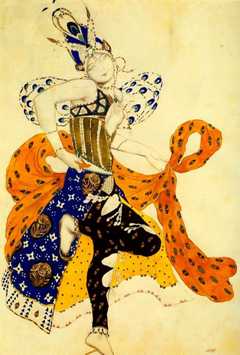Paul Dukas – La Peri - The Sorcerer's Apprentice
Paul Dukas – La Peri - The Sorcerer's Apprentice

1. La Peri Orchestre de Bordeaux Aquitaine Roberto Benzi – conductor 2. The Sorcerer's Apprentice New York Philharmonic Leonard Bernstein – conductor
Dukas' final significant work, the 20-minute ballet La Péri (subtitled "Poème dansé") was written for dancer N. Truhanova and was premiered by her on a program that also included dances to Schmitt's La tragédie de Salomé, d'Indy's Istar, and Ravel's Valses nobles et sentimentales (here retitled Adélaide). La Péri fit perfectly in this company, with its dreamy manipulation of two exotic themes in an orchestration Dukas intended to resemble "a kind of translucent, dazzling enamel." This is Dukas' most Impressionistic score, with the primary themes used as vehicles for explorations of mood and timbre. The orchestra can make a powerful noise in the work's many passionate sections, but at least half the score is given over to quiet washes of strings and delicate swirls of woodwinds, with Middle Eastern flavor provided by a few extra percussion instruments, notably the tambourine. In the story, which is based on an ancient Persian legend, Iskender (Alexander the Great) at last finds the Flower of Immortality in the hand of a sleeping Péri, or fairy. Iskender snatches the flower, which distresses the now wide-awake Péri; without it, she cannot serve Ormuzd, the god of light. Iskender becomes aroused by the Péri, who performs a seductive dance while the Flower of Immortality causes Iskender's face to glow red with desire. Realizing himself unworthy, he willingly hands back the flower; with it, the Péri rises into the light while Iskender recedes into the shadows and, presumably, death. The score begins with a regal, questing brass fanfare in ternary form, a piece written, and often played, separately. The dance music itself falls into three parts. The first opens with shimmering strings and mysterious horn calls, leading to variations on Iskender's sinuous, ever surging-and-receding theme. A mysterious transition leads to the second part, the Péri's dance, which is really a set of variations on her own more ecstatic theme. Dukas then developed the two themes together, eventually bringing them to a shattering climax. The final part is a brief epilog in which the Péri's theme, now dreamy and increasingly distant, mingles for the last time with Iskender's, which is now much calmer and broader than it initially was. The music dies away into the muted horn calls of the beginning. ---James Reel, Rovi
On January 3, 1897, the premiere of Dukas' great Symphony in C met with a cool reception. An impressive Beethovenian overture, Polyeucte (inspired by Corneille's play), had been heard in 1892, the year in which Dukas began his career as a critic, covering productions of Wagner operas in London. Behind him lay an undistinguished apprenticeship at the Paris Conservatoire and a year's military service. Older colleagues, d'Indy and Saint-Saëns foremost, recognized his talent. The latter tapped him to orchestrate Guiraud's uncompleted Frédégonde, and edit several operas for a new Rameau edition, despite the fact that he lacked a public profile. That literally changed overnight on May 18, 1897, with the premiere of The Sorcerer's Apprentice; it became one of the most popular orchestral works ever penned, long before Disney's animated version for the 1940 film Fantasia.
The public has always responded avidly to pictorial and literary associations in music. In matching Goethe's laconic ballad Das Zauberlehrling with an orchestral showpiece, Dukas found unmistakable musical equivalents for the events of the poem, and did so with formal concision. Teasingly called a scherzo by its composer, this resourceful, brilliantly orchestrated work is cast as a compact sonata movement with four themes that are tenuously alluded to in a brief introduction depicting an aura of mystery as the old sorcerer leaves his atelier. Quietly descending thirds in the strings suggest magic -- and later the water that magic summons -- yielding to the softly enunciated broomstick theme on clarinets. The apprentice makes a sudden appearance in a skittering, vacillating rush before quiet descends again, and the commanding theme of the master's spell is heard as if from a distance, on muted brass. With startling abruptness, the spell motif rings out on trumpets combined with the broomstick motif pizzicato. The magic has been worked and the introduction ends with a single tympani stroke. The exposition proper begins now as the lurching broomstick theme gradually shudders to strident, march-like life, drawing in the descending minor thirds signifying water and sorcery. Development proceeds relentlessly with the enchanted broomstick filling the apprentice's bath, which overflows, becoming an inundation. Despite his frantic cries and the partial enunciation of the spell motif -- or the apprentice has forgotten the words -- the broomstick heedlessly continues. To a mighty climax, he seizes an axe and cuts the broom in two. For a moment this seems to have worked. But slowly, shudderingly, "two" brooms -- the theme in canon -- begin to draw water, initiating the recapitulation. Tension escalates even more alarmingly, but this time the climax is capped by the authoritative pronouncement of the spell motif, signaling the master's return, at which a crashing orchestral tutti brings all to a halt. The mysterious quiet of the beginning returns as the waters dissipate and the apprentice's theme, now supplicating, is heard twice before a triplet rush to the final "once upon a time" chord.
The indebtedness of the stormier parts of The Sorcerer's Apprentice to the Ride of the Valkyries has been noted a number of times, while the adroit use of Wagner-like motifs is self-evident. Nietzsche referred to Wagner as "the old Sorcerer" -- it is not too much to see in The Sorcerer's Apprentice, a masterpiece demonstrating that Dukas had not only learned "the lessons of the Master," but cunningly combined them with the French penchant for formal clarity. --- Adrian Corleonis, Rovi
download: uploaded anonfiles yandex 4shared solidfiles mediafire mega filecloudio
Zmieniony (Piątek, 01 Listopad 2013 15:06)








